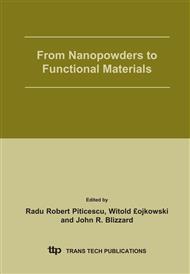p.23
p.27
p.31
p.35
p.41
p.47
p.57
p.63
p.75
Microstructural Characterization of BaTiO3 Ceramic Nanoparticles Synthesized by the Hydrothermal Technique
Abstract:
BaTiO3 (BT) nanoparticles were prepared by the hydrothermal technique using different starting materials and the microstructure examined by XRD, SEM, TEM and HRTEM. X-ray diffraction and electron diffraction patterns showed that the nanoparticles were the cubic BaTiO3 phase. The BT nanoparticles prepared from the starting materials of as-prepared titanium hydroxide and barium hydroxide have spherical grain morphology, an average size of 65 nm and a fairly narrow size distribution. A uniform diffraction contrast across each single grain is observed in the TEM images, and the clear lattice fringes (with d110 = 0.28 nm) observed in HRTEM images reveal that well-crystallized BT nanoparticles are synthesized by the hydrothermal method. The edges of the particles are very smooth, with no surface steps. BT nanoparticles with average grain size of 90 nm, synthesized using barium hydroxide and titanium dioxide as the starting materials, show surface facets. In this case a bimodal size distribution of large faceted and smaller particles is observed. Diffraction contrast variation across the particles caused by high strains within the particles is clearly observed. The high strains obviously stem from structural defects formed during hydrothermal synthesis, presumable in the form of lattice OH− ions and their compensation by cation vacancies. HRTEM images demonstrate that surface facets parallel to the (100) and (110) planes and small islands with 3 ~ 4 atomic layer thickness are frequently observed around the edge of the particles.
Info:
Periodical:
Pages:
41-46
Citation:
Online since:
September 2005
Authors:
Price:
Сopyright:
© 2005 Trans Tech Publications Ltd. All Rights Reserved
Share:
Citation:


